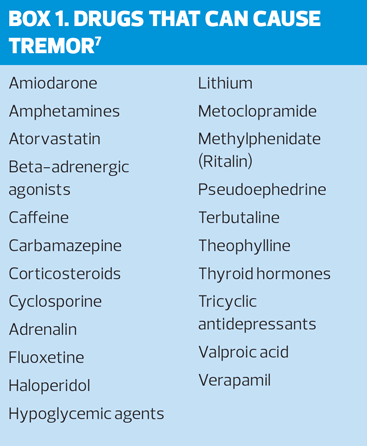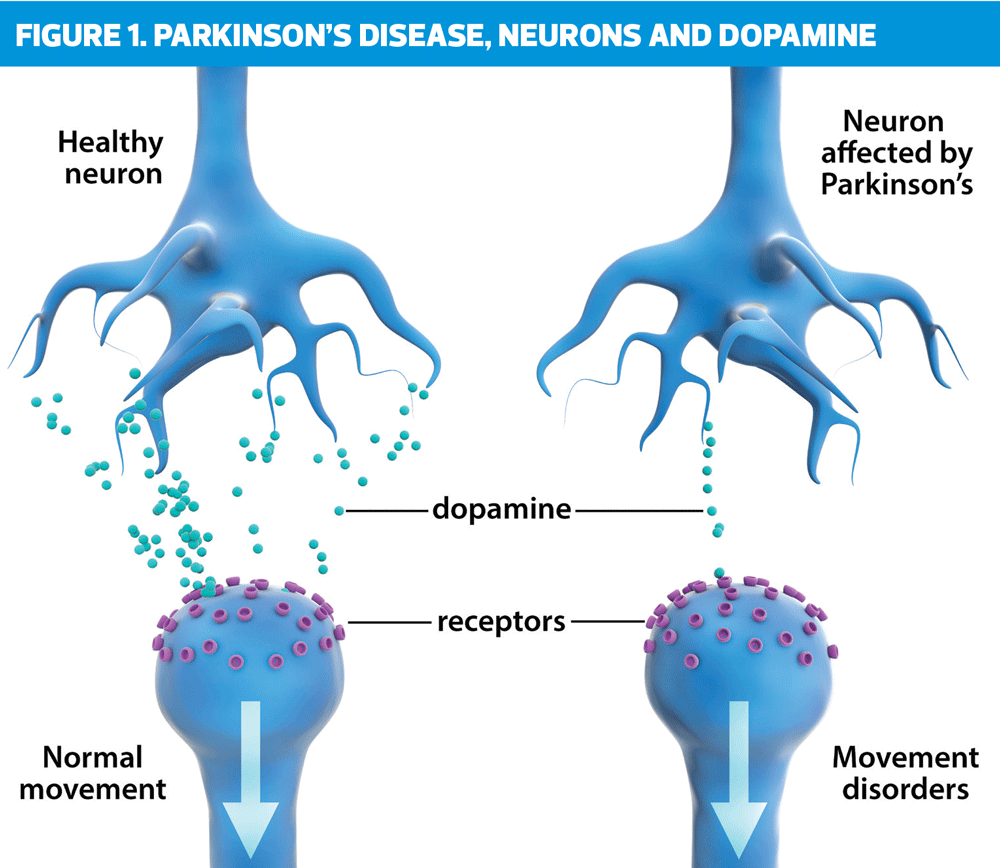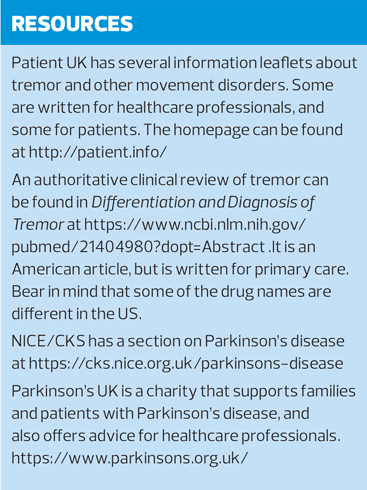Neurological symptoms in primary care. Part 5: Tremor
DR ED WARREN
DR ED WARREN
FRCGP, FAcadMEd
Tremor is one of a number of abnormal, involuntary movements. In many cases it is mild and does not cause significant difficulties, but it can become exaggerated and cause severe impairment
Let’s try an experiment. Hold your right hand out in front of you, and watch it carefully. Can you see it trembling, just a bit? If you can’t see anything, then keep it held out for a minute or two until your shoulder starts to get tired, and now look again.
Tremor is rhythmic oscillatory movement of a body part.1 Everyone has a tremor – it is normal, and called a physiological tremor. The muscles that raise and lower your shoulder are in a constant battle against gravity and against each other to keep your hand still. If your hand moves, impulses go to your brain to recognise what is happening, and then there is a motor surge to correct the movement. Naturally for this to work properly, you need functional joints, functional muscles, functional nerves, and a functioning brain. Those of you who read the article on Dizziness (Practice Nurse, November 2016) may recall that the same pathways are used for maintaining a sense of balance – everything has to be in good order to retain normality. It is the same with tremor.
Physiological tremor is a fact of life, and does not usually cause any problems, if indeed it is even noticed. However, sometimes physiological tremor becomes exaggerated, and there are other types of tremor which are associated with recognised disease processes. They become a problem because of the disease they may indicate, because they provoke worry about the possibility of such disease, and because they cause disability and affect everyday activities including eating and drinking.
Tremor is one of a number of abnormal involuntary movements, or dyskinesias (dys is the Greek for bad or difficult, and kinesis the Greek for movement2). Others include:3
- Athetosis, a sinuous, slow, involuntary writhing movement affecting mainly the fingers, hands, toes and feet;
- Chorea, continuous jerky movements in which each movement is sudden and the resulting posture is held for a few seconds, usually affecting the head, face or limbs;
- Dystonia, sustained muscle contractions, frequently causing repetitive twisting movements or abnormal postures;
- Hemiballism, wild flinging/throwing movements of one arm or leg, usually occurring as a result of a stroke;
- Myoclonus, rapid muscle jerks that are frequently repetitive and cause significant disability;
- Spasmodic torticollis, (Wry neck2) a twisting of the head and neck caused by a neck muscle spasm, tipping the head toward the shortened muscle, while rotating the chin;
- Tardive dyskinesia, characterised by orofacial mouthing with lip-smacking and tongue protrusion, body rocking and chorea of the extremities; and
- Tics, a repetitive twitch at just one site, usually benign and self-limiting.
Invariably, patients presenting with one of these problems for the first time will end up being seen by a medical colleague in the practice. The urgency of this appointment is determined by the likelihood of the problem needing prompt treatment. These ‘red flags’ are:4
- Sudden onset (may be a stroke or transient ischaemic attack)
- Progressive (may be an ongoing disease process such as multiple sclerosis [MS] or a brain tumour)
- Getting worse in a stepwise manner (also suggestive of stroke or MS)
- Neurological deficits present (there is more going on than just the tremor)
- Age under 50 years in the absence of family history of essential tremor (see later discussion of the genetics of essential tremor – essential tremor is the main benign tremor presenting at a young age, other causes are less likely to be benign).
PHYSIOLOGICAL TREMOR
This is most noticeable in the hands, and is usually equal on each side of the body. It is termed a low amplitude, high frequency tremor (the hands don’t move very far, and the tremor is quite rapid). It does not get worse over time, and there are no other symptoms. The tremor may alter with posture, and can also be made worse by anxiety, hyperthyroidism, hypoglycaemia, caffeine excess, fever, and medication, among others.1
Treatment is not usually warranted. However, any anxiety should be treated on its own merits. Hyperthyroidism will need treating. Hypoglycaemia may also need management if it is recurrent, and found in a person known to have diabetes. It is wise to suggest to anyone with a troublesome tremor that they moderate their caffeine input: the recommended daily maximum dose is 400mg a day,5 which is comfortable exceeded by two large cups of coffee, but individual susceptibility is also important. If the caffeine is causing symptoms then you are drinking too much coffee (and you also get caffeine in tea and fizzy drinks).
Essential tremor
This affects around one-in-20 people, in half of whom there is a family history (it is transmitted genetically as an autosomal dominant). The inherited form usually starts in childhood, whereas the non-genetic form typically starts around age 40.6 It is progressive so that most patients only come to healthcare attention around age 70 years. It used to be called ‘benign’ essential tremor, but it is far from benign – about a quarter of sufferers have had to either retire or alter their career because of the disorder.7
Hands and wrists are usually affected, but it can involve head, neck and voice. For each person the amplitude of the tremor is very variable, but the frequency (fairly rapid) stays the same. It is mainly an action tremor, so that it gets worse when you try to do something, and goes away during sleep.1 Many patients can exert a degree of control over their symptoms, so that if they concentrate hard, or do something of a skilled manual nature, then the tremor is improved. One popular diagnostic test is that the tremor nearly always goes away after drinking alcohol, at a suggested dose of two units a day:7 this is a problem area as healthcare workers do not have too much experience of encouraging patients to drink more alcohol; two drinks a day is getting close to the recommended maximum consumption; and alcohol withdrawal in the serious alcohol users can cause a similar tremor. Some readers may recall a famous professional snooker player who used significant quantities of lager to stop him having a tremor when playing: his behaviour finally came to public attention not because of the quantity of alcohol consumed, but because he tried (unsuccessfully) to claim tax exemption for the cost of the lager as a business expense.
Alcohol is not the only available treatment for essential tremor. Further assessment is often needed.
Medication tremor
A significant number of prescribed medications can cause tremor. These are usually stimulants such as amphetamines, beta agonists such as salbutamol, and pseudephedrine as is found in several remedies for the common cold, or else psychoactive drugs, typically strong tranquilisers such as haloperidol, but also more widely used drugs such as SSRI – and older tricyclic – antidepressants such as fluoxetine and amityiptylline (Box 1). The key here is to relate when the drug was started (or the dose increased) to the start of the tremor.
Parkinsonism
This is the one that many patients fear when they ask a healthcare professional about their tremor. Parkinsonism can be cause by several things, for example drugs and after a stroke. On the other hand Parkinson’s disease is a discrete disease caused by degeneration of part of the brain (Figure 1): this is the type of Parkinsonism that most people have heard of.
Parkinson’s disease affects about 2-in-1,000 people.8 It is a problem of advancing age, so that over 65 years 1% of people are affected: however, it is not just a disease of the elderly, and 6% of sufferers are under 50 years old. Men get it more often than women.8
The possibility of Parkinson’s disease will nearly always lead to a referral to hospital (NICE8 recommends that all cases are seen within 6 weeks, and complex cases within 2 weeks), and indeed many areas have access to a specified movement disorders clinic in which the overwhelming majority of the patients seen will have Parkinson’s disease. Treatments (usually medication) are available for Parkinson’s disease. However, the results of using medication are often disappointing – the disease process is not altered, but symptoms may be alleviated. The dose of medication tends to have to increase over time, and eventually may stop working all together. In some severe cases, surgery may help symptoms, but even Parkinson’s UK (a charitable organisation) suggests that such surgery should not be agreed to by patients without a lot of thought about the advantages and disadvantages.9 Whatever other treatment, patients with Parkinson’s disease and their families will need a lot of support as the illness progresses (as it invariably will), and even though ongoing treatment will be a joint venture with secondary care, many GPNs will find themselves as a first port-of-call.
More than 70% of people with Parkinson’s disease will present initially with a tremor.7 This typically occurs at rest and mainly in the arms and hands, and is frequently described as ‘pill-rolling’ – the thumb and fingers look as though they are rolling a small pill. So the characteristic presentation is of an elderly male sitting resting their hands on the chair arms, and displaying a finger tremor of low frequency. At least at first, activity improves the tremor.
Usually one hand starts to tremor before the other, but eventually both hands are involved. As the illness progresses, your patient may develop a shuffling gait (progression of the condition causes rigidity and balance problems), and a loss of ability to show facial expressions. A widely used test shows micrographia – a tendency to write very small. Eventually your patient may succumb to weight loss and a characteristic form of dementia which is found in sufferers. You can understand why people with a tremor are scared that they might have Parkinson’s disease.
QUESTIONS TO ASK
It is unlikely that a GPN will ever be required to make a final diagnosis of a tremor without backup from within the practice and from secondary care. However, GPNs’ skills in talking to patients mean there is a lot of useful information that can be gathered.10
- What is the tremor like? Is it a tremor, or something different like a tic? Is it both hands or just one? Does it involve the head and neck?
- When does it happen? A tremor when trying to do something suggests essential tremor, a tremor at rest suggests Parkinsonism.
- When did it start, and does it come and go? Essential tremor may start at a young age, whereas Parkinson’s disease tends to affect an older patient group (but this distinction is not completely conclusive).
- Is it getting worse?
- Does anything make it better or worse? Is it worse when you are worried about something? Is it better after a drink of alcohol?
- Do you get any other symptoms beside the tremor? This might suggest a more extensive neurological problem.
- Are you taking any drugs or medicines? These may be prescribed, bought over-the-counter, or illicit. Details of prescribed medication are often readily available from the practice computer, but keep in mind that almost no one takes their medicines exactly as prescribed.11 Many patients do not regard over-the-counter treatments as drugs at all. In some traditions, for example Chinese medicine, it is nearly impossible to work out the dose of what is being taken as treatments are often brewed by patients from raw materials. The problems of getting information about illicit drugs are self-evident.
- What is your alcohol and caffeine consumption? On both counts, too much and sudden withdrawal can cause problems.
- Has anyone in your family got a similar problem? For around half of patients, essential tremor is inherited.
CONCLUSION
As long as your patient is definitely suffering from a tremor, and not from one of the plethora of other movement disorders, then he or she is most likely to have essential tremor, and most likely to fear that he or she has Parkinson’s disease. Watching the tremor, and asking focussed questions to find out the context and background will get you to an explanation in most cases. However, it is also important to explore any fears that your patient may have: addressing these fears is an important aspect of any management plan.
The definitive diagnosis of a tremor is usually left to the medical team, and a hospital referral for clarification is the frequent outcome. For many people, a tremor is a worry, but otherwise just a minor inconvenience. For others, further investigation and specialised treatment will be required.
REFERENCES
1. Newson L. Tremor. Patient UK http://patient.info/doctor/tremor-pro 2. Concise Oxford English Dictionary ed. Soanes C & Stevenson A. Oxford University Press (11th edition), 2004
3. Tidy C. Abnormal Involuntary Movements. Patient UK. http://patient.info/doctor/abnormal-involuntary-movements
4. Kochhar S. Red flag symptoms – Tremor. GP http://www.gponline.com/red-flag-symptoms-tremor/neurology/article/1346956
5. Mayo Clinic. Caffeine: how much is too much? http://www.mayoclinic.org/healthy-lifestyle/nutrition-and-healthy-eating/in-depth/caffeine/art-20045678
6. Louis ED, Clark LN, Ottman R; Familial versus Sporadic Essential Tremor: What Patterns Can One Decipher in Age of Onset? Neuroepidemiology. 2015 May 7;44(3):166-172.
7. Crawford P and Zimmerman EE. Differentiation and Diagnosis of Tremor. American Family Physician 2011;83(6):697-702.
8. NICE/CKS Parkinson’s disease. https://cks.nice.org.uk/parkinsons-disease
9. Parkinson’s UK. Surgery. https://www.parkinsons.org.uk/content/surgery
10. Pipis M et al. 10 minute consultation: Tremor. BMJ 2013;347:f7200
11. George C F. How to get your patients to take their medicine. Update 1994:48:518-23.
Related articles
View all Articles


